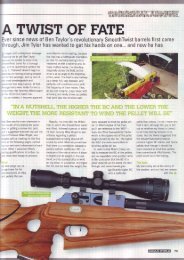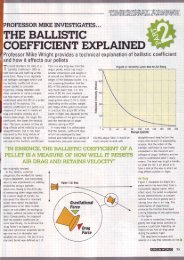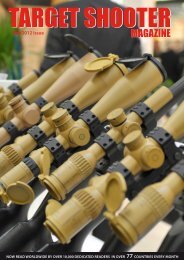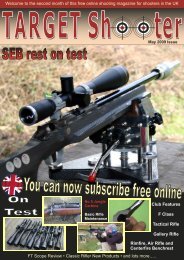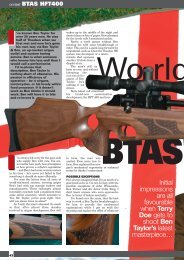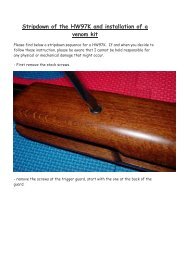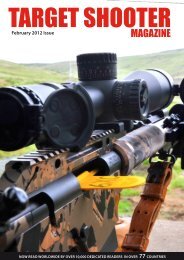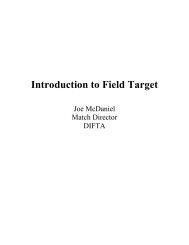Target Shooter 1
Target Shooter 1
Target Shooter 1
Create successful ePaper yourself
Turn your PDF publications into a flip-book with our unique Google optimized e-Paper software.
Military surplus supplies have dried up, and<br />
even newly manufactured 7.62mm<br />
cartridges are unobtainable. Note nickel<br />
washed steel bullet jackets on these<br />
German DAG cartridges dating from 1993<br />
a sound and flexible workhorse thanks to large<br />
dollops of taxpayer funded R&D. Such cartridges<br />
are invariably popular too amongst the world’s<br />
numerically largest group of recreational shooters,<br />
US citizens, promoting a huge choice of factory<br />
ammunition and handloading components. Our<br />
subject dates from the late 1940s / early 1950s<br />
when the NATO alliance countries were looking<br />
for a common cartridge to replace the ragbag of<br />
mostly 19th century designs<br />
then in service. The British,<br />
Belgians and Canadians<br />
made a strong play for a<br />
series of modest sized 7mm<br />
rounds developed in the UK,<br />
but the Americans would have<br />
none of it – .30-calibre and<br />
something approaching .30-06<br />
M2 performance (152gn bullet<br />
at 2,805 fps) was de rigueur,<br />
so we got the 7.62X51mm,<br />
or 7.62 NATO, initially<br />
developed as the T65 series of<br />
experimental cartridges.<br />
Despite it being regularly<br />
stated that the 7.62mm, or<br />
to be precise its finalised<br />
T65E3 progenitor, is a<br />
shortened .30-06, that’s<br />
not how the US Army and<br />
Winchester designers did it.<br />
Its parentage was actually the<br />
.300 Savage, sensibly enough<br />
as Savage had designed<br />
its cartridge with the same<br />
objective 30 years earlier<br />
– a short cased round that would match .30-06<br />
performance with 150gn bullets. However, the<br />
.300 Savage based T65 case couldn’t supply<br />
enough velocity to satisfy the US Army, and was<br />
progressively lengthened to hold more powder,<br />
ending up giving a 144-147gn bullet 2,800fps<br />
MV. One significant difference from earlier<br />
British and American military numbers was<br />
the adoption of a boat-tailed bullet to give<br />
.308 v 7.62 case-heads, the latter using far heavier / thicker primers. Note the NATO-compliance<br />
symbol in the RG headstamp (a cross within a circle)<br />
68 <strong>Target</strong> <strong>Shooter</strong>



